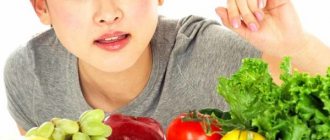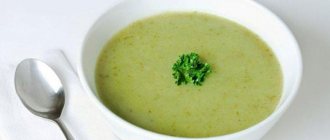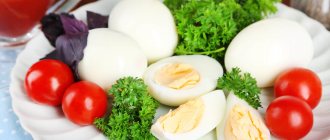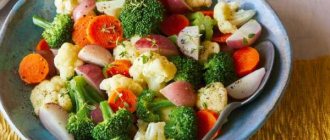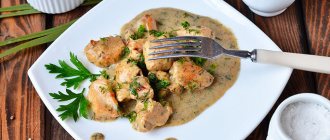The constantly changing world around us, regular stress at work and at home, environmental pollution, poor environmental conditions, artificial additives in food and other factors have led many people to such an unpleasant and sometimes even dangerous phenomenon as allergies. A hypoallergenic diet, the menu of which we will look at today, will help cope with its symptoms.
What is a hypoallergenic diet
Not every type of diet is intended for weight loss; some nutritional systems are designed for people who, for medical reasons, cannot consume certain groups and types of foods, due to the body’s painful reactions to them.
A food allergy or intolerance is an abnormal reaction of the body to a particular food. It can manifest itself as hives, an itchy rash, fever, swelling of the skin and mucous membranes. Moreover, this often does not depend in any way on the amount of allergen consumed. In order not to provoke such reactions, foods containing allergens should simply be excluded from the diet.
Why is this diet needed?
Not drinking milk or eating gluten-containing foods is not a big deal. However, what about those who do not fully understand what the body’s negative response is to, how to avoid risks and temptations? For this case, a hypoallergenic diet has been developed and tested in practice, the list of products for which we will consider below.
In this way, you can significantly reduce the allergic load on the body and feel good every day. Alternatively, you can enter the diet gradually, eliminating foods one by one. This will help identify the allergen and easily take measures to prevent relapses in the future.
Key Nutrition Principles
There are a number of general principles and rules that will help get rid of the negative consequences of allergies. You should follow them strictly to get the maximum positive effect.
- You can only use light products that do not overload the gastrointestinal tract.
- Nutrition should be balanced, and foods filled with vitamins, micro- and macroelements.
- Food should be varied.
- Salt intake per day is reduced to 7 grams per 24 hours.
- The maximum calorie intake per day on a hypoallergenic diet should not exceed 2800 kilocalories.
- It is important to maintain the correct drinking regime. You need to consume approximately 1.5-2 liters of liquid per day, including drinks and soups.
- Meals should be regular and fractional. It is advisable to plan for yourself 5-6 meals in small portions.
- All foods can be boiled, stewed, steamed, baked, but it is better not to fry; they often act as powerful allergens.
- Animal whiteness can be a serious problem, so strong broths are usually boiled by changing the water several times.
- Food should be consumed warm, as cold and hot can irritate the intestinal walls and excite the nervous system, which often leads to relapse.
To make it easier to identify allergens that lead to a negative response from the body, it is better to prepare the simplest dishes, consisting of a small number of components.
To be able to track your body’s reactions to a particular food product, it is advisable to keep a diary. There you need to write down all the details of the diet: the time of food consumption, its quantity, the ingredients from which it was prepared, whether there was a reaction or not.
Breakfast
The most popular dishes to start the day are all kinds of porridges: oatmeal, buckwheat, pearl barley, barley, rice, corn, wheat, millet, etc. For children, they are usually boiled in milk or water with milk - it helps the vegetable proteins of the grains to be absorbed. In our case, you will have to cook only with water (3 parts of water for 1 part of cereal). Instead of cow's milk, you can try using soy, oat or rice milk. “Choose whole grain porridges, they are healthier: they have a lot of fiber, they are digested more slowly and provide energy for a longer period, so you don’t feel hungry for a long time after them,” says Natalya Fadeeva. — Instead of whole grain oatmeal, you can use Hercules flakes, which are boiled for at least 10 minutes. Porridge cooked in water can be served with a small amount of yogurt, cottage cheese, a piece of cheese or any fermented milk product.” Do not replace whole grain cereals with refined products (muesli, cereal, instant cereals). The child quickly gets used to their sweet taste, and switching him to a less tasty, but much more healthy educational porridge is much more difficult than immediately accustoming him to proper food. Berries, finely chopped fruits, a small amount of honey or jam will help improve the taste of the dish.
Buckwheat krupenik
Ingredients: 150 g buckwheat, 175 g cottage cheese (up to 5%), 1 egg, 30 g 4% fat yogurt, 1/2 tsp. salt, 10 g butter.
Instructions. Cook crumbly buckwheat porridge, add cottage cheese, pureed with egg and salt. Mix everything, place on a greased baking dish and bake in the oven or microwave. Serve with yogurt. If the dish is intended for lunch, it is good to add a vegetable salad or soup with vegetables to it.
Pancakes with nuts
Ingredients: 1 tbsp. soy or rice milk, 2 quail eggs, 1 tbsp. olive oil, 1.5 tbsp. corn flour, sugar, salt, vanilla to taste. For filling: 5 walnuts, 1 tsp. jam.
Instructions. In a blender, beat eggs, salt, sugar, milk, butter and vanilla. Then add flour, stirring constantly. Prepare the filling by chopping the nuts in a blender and mixing them with the jam. Fry the pancakes in a “dry frying pan” without oil. They should be voluminous. Make a cut in the pancakes and fill with filling.
Berry sauce
Ingredients : 290 g of any berries (strawberries, blueberries, blueberries, lingonberries, etc.), 1 tbsp. powdered sugar, 1 tbsp. lemon or orange juice.
Instructions. Mix all ingredients and grind with a blender. Serve with cereals and fruit salads.
Unwanted Products
- Products containing a large number of chemical additives: stabilizers, dyes, preservatives, flavors, emulsifiers and others.
- Hard cheese.
- Dairy products with high fat content.
- Sausage, frankfurters, sausages.
- Canning and pickling, pickled rolls.
- Smoked meats.
- Nuts.
- Seafood and fish, especially fatty varieties.
- Red and black caviar.
- Fruits and vegetables of red and orange color (oranges, grapefruits, beets, carrots, tomatoes).
- Berries and dried fruits.
- Chicken eggs.
- Natural bee honey.
- Chocolate and candies.
- Bread, bakery products, pastries, muffins.
- Mushrooms.
- Coffee and cocoa.
- Store-bought mayonnaise and sauces.
- Store-bought juices.
- Carbonated drinks, especially sweet ones.
- Exotic delicacies.
- Alcohol.
Products that are approved for consumption
- Dietary meats.
- Vegetable oils.
- Low-fat milk and lactic acid products.
- Dietary varieties of fish.
- Compotes, weak tea, natural juice, water.
- Some dried fruits.
- By-products: kidneys, liver, beef tripe, heart.
- Green fruits and vegetables.
- Fresh greens.
- Porridge.
- Vegetarian soups.
- Pickled cheeses, in particular feta cheese.
Features of a hypoallergenic diet for children
Adults can stick to this diet for 21 days to get results, but for children it’s better to limit it to a week. If you cannot identify the allergen, you can take a break for a week and continue trying.
Diet rules for a nursing mother
Pregnant women should take care not only of their own health, but also of the condition of the baby. Therefore, you will have to take special care in selecting products for a hypoallergenic diet. Nutrition, first of all, should be diverse, varied and balanced, including all the substances necessary for the development of the fetus.
Diet for atopic dermatitis
People suffering from atopic dermatitis will have to adhere to all the rules and norms of nutrition, because they know firsthand what a hypoallergenic diet is. It is important to completely exclude all products that are potentially highly harmful to the gastrointestinal tract, for example, fried, smoked, pickled, canned. If the disease takes a chronic form, then you will have to adhere to restrictions throughout your life and/or at least during periods of exacerbation.
Recipes for hypoallergenic dishes
The basic principle for choosing recipes is that ready-made dishes should have a beneficial effect on the digestive tract. For this reason, salting, pickling and fermentation are completely excluded. Steaming or boiling is considered to be gentle on the stomach. Such preparation methods help reduce the allergenic activity of the ingredients used. It is also better to eat fruits and vegetables not raw, but stewed or baked.
First
The list of the first hypoallergenic dishes includes mainly soups. Potatoes are often used for cooking. It is recommended to pre-soak it in cold water. To reduce the amount of starch in a vegetable, a couple of hours is enough. The soup broth should be the second or third. This means that after boiling, the liquid is drained 1-2 times. This way the fat content of the finished soup will be much lower.
Vegetable soup with wheat cereal
The peculiarity of this soup lies in a special ingredient - celery. Dishes with it are often present in various diets, including hypoallergenic ones. Celery tastes like carrots and parsley. Its leaves have a spicy and fresh aroma. The benefits of celery are manifested not only for allergies, but also for weight loss. In the soup according to this recipe, it is combined with potatoes, cabbage and dill. Garlic adds a little spice to the dish.
Ingredients:
- onions – 0.5-1 pcs.;
- white cabbage – 100 g;
- crushed wheat cereal (bulgur) – 50 g;
- celery – 1 small root;
- water – 1.5-1.6 l;
- potato tubers – 3 pcs.;
- dill or other greens - 1 sprig;
- garlic clove – 2 pcs.
Cooking method:
- Boil water, put bulgur in it.
- Next, cut the peeled potatoes and add them to the broth.
- Peel the onion, chop finely, add to the rest of the ingredients.
- Rinse the celery and place it in the broth.
- After the next boil, reduce the heat.
- Simmer covered for 15-20 minutes.
- Take out some of the potatoes, mash them and put them back.
- Wash the cabbage leaves, dry them, chop them and put them in the almost finished soup.
- Cook for another 10 minutes, then remove and discard the celery.
- Finely chop the greens and garlic cloves and season the soup with them.
Potato soup with vermicelli
To prepare this dish, a minimum amount of ingredients is required. The soup is suitable for both adults and children. The onion in the broth is practically not noticeable, since it is boiled. Due to the fact that the vegetable is added at the very beginning of cooking, the meat turns out very tasty. It is possible to replace chicken with lean beef, but the soup will be a little fattier and will take 30-60 minutes longer to prepare.
- The world is facing an obesity pandemic
- Hyaluronic acid tablets
- What kind of alcoholic drinks can people who play sports drink?
Ingredients:
- small onion – 1 pc.;
- greens - to your taste;
- chicken fillet – 800 g;
- premium vermicelli – 200 g;
- potato tubers – 4-5 pcs.;
- water – 4 l.
Cooking method:
- Pour water over the well-washed meat and place the pan on maximum heat.
- Bring to a boil, drain the liquid.
- Pour in the same amount of water again, boil again, skim off the foam.
- At this time, peel the onion, chop finely, and add to the broth.
- Reduce heat to low, cook for 30-40 minutes until the meat is cooked, then remove it, cut into pieces and send back.
- Separately, boil the vermicelli in slightly salted water. This is necessary so that sediment does not cause the broth to become cloudy.
- Peel the potatoes, rinse, chop into slices. Place the slices in the broth and cook for 5 minutes.
- Next, season the soup with boiled vermicelli.
Second
The basis of second courses is also vegetables or meat. Cutlets, dumplings, meatballs and meatballs are cooked mainly by steaming. You can make puree, goulash and even beef stroganoff or soufflé from the meat. In the recipe for the last dish, minced meat is mixed with milk sauce, yolk and whipped whites. The soufflé is suitable for the stage when you begin to gradually introduce foods with a moderate degree of allergenicity. Vegetables can be served as a side dish for meat, but they can only be stewed, boiled or baked, since frying increases the allergenicity of the ingredients.
Cabbage and zucchini soup
The advantage of puree soup is its uniform, soft consistency, due to which the dish does not irritate the stomach and intestines. These recipes use not only meat, but also vegetables. An unusual combination is zucchini and cauliflower. The first vegetable has a neutral taste, so it goes well with many ingredients. In addition, they have no contraindications. Cauliflower is not recommended for problems with the gastrointestinal tract.
Ingredients:
- zucchini – 2-3 pcs.;
- onion head – 1 pc.;
- celery – 5–7 stalks;
- parsley – 1-2 sprigs;
- water or weak vegetable broth - 1 l;
- cauliflower – 1 small head;
- low fat sour cream – 100 g.
Cooking method:
- Divide the cauliflower florets into smaller ones, peel the zucchini, then rinse the vegetables, including celery.
- Chop the onion head into cubes. Repeat the same with zucchini, celery, cauliflower.
- Place all the vegetables in the bottom of the pan and add water. Boil and simmer until the ingredients are soft.
- Then cool, transfer to a blender bowl, and beat until smooth.
- Pour the mixture back into the pan, add sour cream, simmer over low heat for a couple more minutes.
- When serving, sprinkle with chopped herbs.
Steamed dumplings
Dumplings are one of the types of dumplings - small balls made from minced fish, poultry or other meat. The difference between dumpling mass and cutlet mass is that it is more fluffy and tender. For this reason, dumplings are more suitable for children's and dietary hypoallergenic diets. Another feature of this dish is steaming, due to which the meat retains more vitamins. In addition, steamed dumplings are easier for the stomach to digest.
Ingredients:
- low-fat milk – 2 tbsp;
- egg whites – 2 pcs.;
- beef pulp – 800 g;
- wheat bread - 1 slice.
Cooking method:
- Soak the bread in half the entire portion of milk and leave for half an hour.
- At this time, pass the meat through a meat grinder.
- Squeeze out the bread, add to the minced meat, grind everything through a sieve.
- Mix the resulting mass thoroughly and add the egg whites.
- Pour in the remaining milk.
- Form the minced meat into medium-sized balls and place them in a steaming dish. Cook for 15 minutes.
Dessert
Although sweets are prohibited on a hypoallergenic diet, you can still diversify your menu with tasty treats. You just need to cook them correctly. The best hypoallergenic desserts are based on fruit, kefir or cottage cheese. The main thing is that fermented milk products are not sour. An ordinary pear, cut into pieces or mashed into a puree, will add sweetness to them. Cottage cheese is the best base for casserole. It can also be prepared with the addition of permitted fruits. Among the latter, baked apples are a popular dessert. They are even combined with cottage cheese - it turns out tasty and healthy.
Cottage cheese casserole
Since eggs belong to the category of products with a high degree of allergenic activity, their use in a hypoallergenic diet, especially for children, is not recommended. The casserole can be prepared without these ingredients. It is also easy to replace flour with semolina, which will provide the dish with a dense consistency. To add a sweet taste, you can add any hypoallergenic fruit to the cottage cheese. Sugar should be added after completing a strict diet, i.e. after 7-10 days.
Ingredients:
- pear – 3 pcs.;
- low-fat cottage cheese – 400 g;
- sugar – 1 tsp;
- semolina – 4 tbsp. l.;
- kefir or yogurt without any additives - 3 tbsp. l.
Cooking method:
- Take a bowl, place cottage cheese with yogurt or kefir in it, mix well.
- Add cereal, sugar. Mix again.
- Wash the pears, peel them and chop finely.
- Add fruit to the curd mass, mix, transfer to a greased baking dish.
- Place in the oven for half an hour. The optimal temperature is 180 degrees.
Baked apples
This is the most popular dietary and at the same time hypoallergenic dessert. Since allergy sufferers are not recommended to eat fresh fruits, they can be baked. It will turn out not only tasty, but also good for the stomach. Apples are the perfect fruit for this dessert. They are baked not only in the oven, but also in the microwave, so preparing the delicacy is very quick and easy. To make the dessert even more healthy, you can stuff the fruits with cottage cheese. Just don’t use recipes where you need to add honey inside the apple.
Ingredients:
- apple – 3 pcs.;
- sour cream with low fat content - 2 tbsp. l.;
- cottage cheese – 100 g;
- vanillin - on the tip of a knife.
Cooking method:
- Wash the apples, cut out the core, but so that the bottom of the fruit remains intact and a kind of cup is formed.
- Mix cottage cheese with sour cream, add vanillin, bring the mixture to a homogeneous consistency.
- Fill apples with curd mixture.
- Place the fruit on a baking sheet and bake for 25–30 minutes at 200 degrees.
Hypoallergenic diet: menu for 7 days
Monday
Breakfast: oatmeal on water with allowed fruits, herbal tea.
Snack: apple.
Lunch: beef soup with vegetables, boiled veal, compote.
Afternoon snack: pear.
Dinner: steamed chicken cutlet, buckwheat with water, tea.
Tuesday
Breakfast: pasta with cheese, herbal tea.
Snack: low-fat cottage cheese.
Lunch: broccoli cream soup, turkey in foil, compote.
Afternoon snack: kefir.
Dinner: steamed sea fish from the permitted list, fruit, tea.
Wednesday
Breakfast: whole grain toast with cheese, tea.
Snack: dried apples.
Lunch: chicken soup with zucchini, fruit jelly.
Afternoon snack: cottage cheese with fruit.
Dinner: stewed meat with potatoes, fruit.
Thursday
Breakfast: millet porridge with water, tea.
Snack: apple.
Lunch: lean borscht, steamed veal cutlet, compote.
Afternoon snack: vegetables.
Dinner: vegetable stew, steamed rice, herbal tea.
Friday
Breakfast: low-fat cottage cheese with fruits and berries, tea.
Snack: pear.
Lunch: cabbage soup without meat, boiled chicken, fruit.
Afternoon snack: baked apples.
Dinner: buckwheat in water, steamed vegetables, boiled meat, tea.
Saturday
Breakfast: whole grain bread, steamed meat, compote.
Snack: apple.
Lunch: soup with noodles and meatballs, compote, fruit.
Afternoon snack: cottage cheese.
Dinner: buckwheat with water, vegetable salad with butter, kefir.
Sunday
Breakfast: cottage cheese casserole, herbal tea.
Snack: banana.
Lunch: cauliflower soup, steamed beef cutlet, tea.
Afternoon snack: fermented baked milk.
Dinner: millet porridge, steamed turkey, compote.
List of hypoallergenic products
When preparing first courses, it is recommended to use vegetable broth without frying. It must be weak, i.e. After 1-2 boils, the water is drained. It is allowed to add various garden herbs. Among the cereals, it is useful to eat oatmeal, buckwheat, and wheat. Potatoes are allowed as a side dish in the form of mashed puree, but only cooked in water. For fermented milk products, you can use low-fat fresh cottage cheese and yogurt without additives.
To enrich the body with fats, you need to introduce sunflower or olive oil into your diet. Pasta should only be made from durum wheat. Other hypoallergenic products:
| Name | Calories per 100 g, kcal | Fats per 100 g, g | Carbohydrates per 100 g, g | Proteins per 100 g, g |
| Vegetables, greens | ||||
| Eggplant | 24 | 0,1 | 4,5 | 1,2 |
| Zucchini | 24 | 0,3 | 4,6 | 0,6 |
| cucumbers | 15 | 0,1 | 2,8 | 0,8 |
| Cabbage | 27 | 0,1 | 0,1 | 1,8 |
| Patissons | 19 | 0,1 | 4,3 | 0,6 |
| Broccoli | 28 | 0,4 | 5,2 | 3,0 |
| Celery | 12 | 0,1 | 2,1 | 0,9 |
| Lentils | 284 | 1,5 | 42,7 | 24,0 |
| Garlic | 143 | 0,5 | 29,9 | 6,5 |
| Asparagus | 20 | 0,1 | 3,1 | 1,9 |
| Bulb onions | 41 | 0,0 | 10,4 | 1,4 |
| Beans | 123 | 0,5 | 21,5 | 7,8 |
| Cereals | ||||
| Oatmeal | 342 | 6,1 | 59,5 | 12,3 |
| Buckwheat | 313 | 3,3 | 62,1 | 12,6 |
| Wheat bran | 296 | 3,8 | 53,6 | 15,1 |
| Manna | 328 | 1,0 | 73,3 | 10,3 |
| Cereals | 366 | 7,2 | 69,3 | 11,9 |
| Fruits | ||||
| Peaches | 46 | 0,1 | 11,3 | 0,9 |
| Nectarines | 48 | 0,2 | 11,8 | 0,9 |
| Apples | 47 | 0,4 | 9,8 | 0,4 |
| Pears | 42 | 0,2 | 10,9 | 0,4 |
| Dairy | ||||
| Kefir 0% | 30 | 0,1 | 3,8 | 3,0 |
| Kefir 1% | 40 | 1,0 | 4,0 | 2,8 |
| Cottage cheese 0.6% | 88 | 0,6 | 1,8 | 18,0 |
| Meat | ||||
| Boiled chicken | 170 | 7,4 | 0,0 | 25,2 |
| Boiled turkey fillet | 130 | 1,0 | 0,0 | 25,0 |
| Boiled beef | 254 | 16,8 | 0,0 | 25,8 |
| Beef stew | 232 | 18,3 | 0,0 | 16,8 |
| Fish | ||||
| Flounder | 90 | 3,0 | 0,0 | 15,7 |
| Halibut | 103 | 3,0 | 0,0 | 18,9 |
| Cod | 69 | 0,6 | 0,0 | 16,0 |
| Sea kale | 49 | 5,1 | 0,0 | 0,8 |
| Beverages | ||||
| Rosehip juice | 70 | 0,0 | 17,6 | 0,1 |
- 7 Changes to Your Body When You Stop Eating Grains
- Fine for smoking in a public or unauthorized place
- Apple jam


